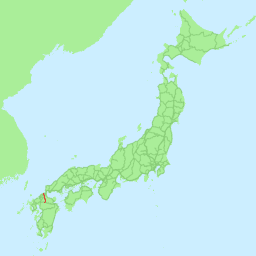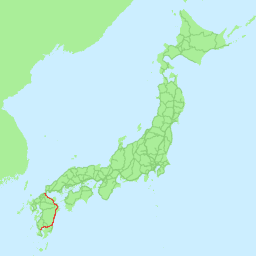|
Heisei Chikuhō Railway Tagawa Line
The is a 26.3 km railway line owned by the Heisei Chikuhō Railway. The line runs west along the Ima River from Yukuhashi to Tagawa, all within Fukuoka Prefecture. History The line was first built in 1895 by the , which was merged in 1901 with Kyushu Railway. It was an important railway line to transport coal between the Chikuhō coal mine with in Kanda, north of Yukuhashi. Kyushu Railway was nationalized in 1907 and was merged into Japanese Government Railway, where it was named the Tagawa Line. In 1942, the line was extended south from Ita Station (now Tagawa-Ita Station) to Hikosan Station. The portion between Hikosan and Soeda Station was later reorganized into the Hita Line (now Hitahikosan Line) in 1956, and the section between Soeda and Ita was also merged into the same line in 1960 to form the current Tagawa Line. Between 1899 and 1973, a short freight-only branch line ran north from Kawara Station (now Magarikane Station) to Natsuyoshi. Ridership suffered wit ... [...More Info...] [...Related Items...] OR: [Wikipedia] [Google] [Baidu] |
Tagawa-Ita Station
is a railway station in Tagawa, Fukuoka, Japan, operated by Kyushu Railway Company (JR Kyushu) and Heisei Chikuhō Railway. On 1 April 2009, discount shop chain MrMax acquired naming rights to the Heisei Chikuhō part of the station. Therefore, the station is alternatively known as . Lines Tagawa-Ita Station is served by the Hitahikosan Line. It is also served by the Heisei Chikuhō Railway Ita Line and Tagawa Line. Adjacent stations See also * List of railway stations in Japan The links below contain all of the 8579 railway stations in Japan. External links {{Portal bar, Japan, Trains * Railway stations A train station, railway station, railroad station or depot is a railway facility where trains stop to ... References External links * * Railway stations in Japan opened in 1895 Railway stations in Fukuoka Prefecture Tagawa, Fukuoka {{Fukuoka-railstation-stub ... [...More Info...] [...Related Items...] OR: [Wikipedia] [Google] [Baidu] |
Hitahikosan Line
The is a railway line in Japan, operated by Kyushu Railway Company (JR Kyushu). It connects Jōno Station in Kitakyushu, Fukuoka Prefecture with Yoake Station in Hita, Ōita Prefecture and features the 4380 m Shakadake Tunnel between Chikuzen Iwaya and Hikosan station, where a fatal tunnel collapse occurred during construction in 1953, killing 21 construction workers. The line is named after Hita and Mount Hiko. Stations :●: Stops, |: non-stop History The Toyo-shu Railway Co. opened the Tagawa-Ita - Buzen Kawasaki section as part of the Tagawa Line in 1899. That company merged with the Kyushu Railway Company in 1901, which extended the line to Soeda in 1903. The company was nationalised in 1907. The Jono - Tagawa-Ita section was opened in 1915 by the Kokura Railway Co., that company being nationalised in 1943. The Soeda - Daigyoji section opened between 1937 and 1946, and the Daigyoji - Yoake section opened in 1956. CTC signalling was introduced on the entire line in 1 ... [...More Info...] [...Related Items...] OR: [Wikipedia] [Google] [Baidu] |
Nippō Main Line
The is a railway line in Kyushu, in southern Japan, operated by Kyushu Railway Company (JR Kyushu). The line connects Kokura Station in Kitakyushu, Fukuoka, and Kagoshima Station in Kagoshima via the east coast of Kyushu, passing through the prefectural capitals of Ōita and Miyazaki. A number of Limited Express trains operate along the route, including Limited Express Sonic trains between Hakata and Oita. Stations :●: Stops :▲: Rapid service connecting to Hitahikosan Line non-stop, :|: Non-stop :Liner services: ''Sawayaka Liner'', ''Home Liner'' Though Kagoshima is the southern terminus for the line, some trains continue via the Kagoshima Main Line to the adjacent Kagoshima-Chūō station. History The Kyushu Railway Co. opened the 6 km Kokura - Jono section in 1895, and the Hōshū Railway Co. opened the 46 km Yukuhashi - Buzen Nagasu section in 1897. The former company acquired the latter in 1901, and was nationalised in 1907. The lines were connected ... [...More Info...] [...Related Items...] OR: [Wikipedia] [Google] [Baidu] |
JR Logo (kyushu)
JR, J. R. or Jr. may refer to: * Jr. or Junior (suffix), a name suffix Arts and entertainment * ''J.R.'' (album), an album by Jim Bob * ''J R'', a 1975 novel written by William Gaddis * "Jr.", a song by Codeine on the album ''Barely Real'' * J. R. Ewing, a television character from ''Dallas'' * JR Chandler, aka Adam Chandler Jr, a television character from ''All My Children'' * ''Jornal da Record'', a Brazilian news program on RecordTV Businesses and organizations * Aero California, defunct Mexican airline by IATA code * Japan Railways Group or the JR Group, the main operators of the Japanese railway network * Jember railway station * John Radcliffe Hospital * Joy Air, Chinese airline by IATA code People In arts and entertainment * JR (artist) (born 1983), French artist * J.R. (musician) (born 1979), American Christian musician and producer * JR (rapper) (born 1987), South African rapper and entrepreneur * ''J. R.'' a pen-name of writer John Ruskin * ''Jr.'', stage name of Par ... [...More Info...] [...Related Items...] OR: [Wikipedia] [Google] [Baidu] |
Arch Bridge
An arch bridge is a bridge with abutments at each end shaped as a curved arch. Arch bridges work by transferring the weight of the bridge and its loads partially into a horizontal thrust restrained by the abutments at either side. A viaduct (a long bridge) may be made from a series of arches, although other more economical structures are typically used today. History Possibly the oldest existing arch bridge is the Mycenaean Arkadiko Bridge in Greece from about 1300 BC. The stone corbel arch bridge is still used by the local populace. The well-preserved Hellenistic Eleutherna Bridge has a triangular corbel arch. The 4th century BC Rhodes Footbridge rests on an early voussoir arch. Although true arches were already known by the Etruscans and ancient Greeks, the Romans were – as with the vault and the dome – the first to fully realize the potential of arches for bridge construction. A list of Roman bridges compiled by the engineer Colin O'Connor featur ... [...More Info...] [...Related Items...] OR: [Wikipedia] [Google] [Baidu] |
Nōgata Station
is a railway station on the Chikuhō Main Line operated by JR Kyushu in Nōgata, Fukuoka Prefecture, Japan. The station also hosts the northern terminus of the Heisei Chikuho Railway Ita Line. Lines The station is served by the Chikuhō Main Line and is located 24.8 km from the starting point of the line at . In addition, the station is the northern terminus and starting point of the Heisei Chikuho Railway Ita line. Station layout The JR part of the station consists of two island platforms serving four tracks. Passing loops run between the platform tracks. In addition, numerous sidings branch off the main tracks. To the west of the station, there are more sidings that belong to the JR Kyushu Nōgata train depot. The Heisei Chikuho Railway part of the station comprises two bay platforms serving two tracks. File:20080331 Nogata Station.JPG, The former station building, since demolished. File:Nogata Station (Heisei Chikuho Railway) 20160429.JPG, The entrance to the Heisei ... [...More Info...] [...Related Items...] OR: [Wikipedia] [Google] [Baidu] |
Single-track Railway
A single-track railway is a railway where trains traveling in both directions share the same track. Single track is usually found on lesser-used rail lines, often branch lines, where the level of traffic is not high enough to justify the cost of constructing and maintaining a second track. Advantages and disadvantages Single track is significantly cheaper to build and maintain, but has operational and safety disadvantages. For example, a single-track line that takes 15 minutes to travel through would have capacity for only two trains per hour in each direction safely. By contrast, a double track with signal boxes four minutes apart can allow up to 15 trains per hour in each direction safely, provided all the trains travel at the same speed. This hindrance on the capacity of a single track may be partly overcome by making the track one-way on alternate days, if the single track is not used for public passenger transit. Long freight trains are a problem if the passing s ... [...More Info...] [...Related Items...] OR: [Wikipedia] [Google] [Baidu] |
Railway Electrification System
A railway electrification system supplies electric power to railway trains and trams without an on-board prime mover or local fuel supply. Electric railways use either electric locomotives (hauling passengers or freight in separate cars), electric multiple units (passenger cars with their own motors) or both. Electricity is typically generated in large and relatively efficient generating stations, transmitted to the railway network and distributed to the trains. Some electric railways have their own dedicated generating stations and transmission lines, but most purchase power from an electric utility. The railway usually provides its own distribution lines, switches, and transformers. Power is supplied to moving trains with a (nearly) continuous conductor running along the track that usually takes one of two forms: an overhead line, suspended from poles or towers along the track or from structure or tunnel ceilings, or a third rail mounted at track level and contacted by a s ... [...More Info...] [...Related Items...] OR: [Wikipedia] [Google] [Baidu] |
Itoda Line
The is a 6.8 km railway line owned by the Heisei Chikuhō Railway. The line runs north from Tagawa to Kanada Station, all within Fukuoka Prefecture. History The Itoda Line was built in two parts. The first part was built in 1897 as a branch line by the , a third-sector railway to transport coal from the Chikuhō Coal Mine. It ran north from Gotōji Station (now Tagawa-Gotōji Station) to Miyatoko Station (now Itoda Station). Hōshū Railway was acquired by Kyushu Railway in 1901, which was then nationalized in 1907 into Japanese Government Railways (JGR) under the Railway Nationalization Act. After being nationalized, the line was known as the . In 1927, another third-sector railway company, , built the section between Miyatoko and Kanada Station. Within the same year, the line was transferred to the , who then changed their name to in 1933. The line was sold in 1943 during the Second World War to JGR, who operated the entire line as the Itoda Line. With the privatizat ... [...More Info...] [...Related Items...] OR: [Wikipedia] [Google] [Baidu] |
Ita Line
The is a 16.1 km railway line owned by the third-sector company Heisei Chikuhō Railway. The line runs north from Tagawa to Nōgata, all within Fukuoka Prefecture. History The line was first built by the Chikuhō Kōgyō Railway, later renamed , as a branch line of the Chikuhō Main Line. Used to transport coal from the Chikuhō coal mine, the line had two stations: Nōgata Station and Kanada Station. The entire Chikuhō Railway system was merged in 1897 with Kyushu Railway, where the line was extended to Ita Station (now Tagawa-Ita Station) in 1899. Kyushu Railway was nationalized in 1907 and was merged into Japanese Government Railway. Even though the Ita Line was widened to a double-track railway in 1911, ridership suffered with the decline of the Chikuhō coal mine. Therefore, JR Kyushu, the successor of Japanese Government Railway, privatized and transferred the Ita Line, Itoda Line, and Tagawa Line to the newly founded Heisei Chikuhō Railway. Even after privatiz ... [...More Info...] [...Related Items...] OR: [Wikipedia] [Google] [Baidu] |



